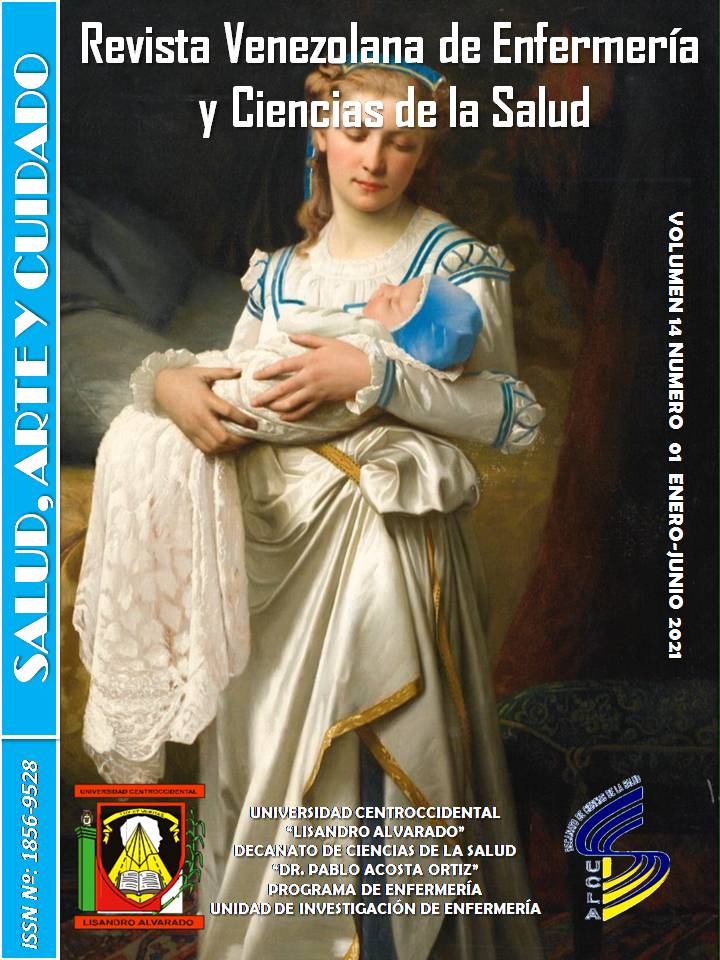Breast milk bank in the Neonatal Pathology Unit
DOI:
https://doi.org/10.5281/zenodo.6969349Keywords:
milk bank, breast milk, neonatal pathology, neonate infantAbstract
Study framed in the feasible project research modality, of descriptive character, supported by a field design, with a quantitative approach, its objective is to promote the existence of a Mothers´ Milk Bank in the Neonatal Pathology Unit of the Dr. Antonio Maria Pineda University Hospital, it was applied previously validated an instrument to 7 nurses from the aforementioned unit. In the results, it is highlighted that 100% of health staff considers necessary the creation of the Mothers´ Milk Bank, in the same way that 100% of the participants opine that the Breast Milk Bank would be beneficial for patients. Finally, 42% of the approached population considers that they have little knowledge about the organization and functionality of the Mothers` Milk Bank. In conclusion, the Bank in the Neonatal Pathology Unit represents a need and a beneficial idea for the patients of said unit. Likewise, it is concluded that the lack of knowledge about the Milk Bank by the Nursing staff represents a determining factor for its creation. All these assertions allowed determining the necessary tools to achieve the existence of the Breast Milk Bank in the Unit, beginning with the promotion through the execution of a protocol about the organization and functionality of the Milk Bank for nursing staff of the neonatal pathology unit, thus modifying one of the factors that condition the existence of the Mothers´ Milk Bank in this Unit.
Downloads
References
Ferrer, L Lactancia materna: ventajas, técnica y problemas. Pediatra Integral. (2015) (4): 243-250 [Revista en Línea] Consultado el 10 de octubre de 2019. Disponible en: https://www.pediatriaintegral.es/wp-content/uploads/2015/xix04/02/n4-243 250_laila%2520de%2520antonio.pdf&sa=u&ved=2ahukewjn14xys5zlahxmxfkkhsjfcwmqfjabegqlahab&usg=aovvaw2aokb1mhyxuvmuk8fsetqs.
Ley de Promoción y Protección de la Lactancia Materna. Gaceta Oficial Nº 38.763. República Bolivariana de Venezuela (2007).
Asociación Española de Pediatría. Comité de Lactancia Materna. [Documento en Línea]. Consultado el 04 de Julio de 2019. Disponible en: http://www.aeped.es/sites/default/files/documentos/201801-bancos-leche.pdf
Centeno, J. García, G. Lactancia Materna Exclusiva a través del Banco de Leche y orientaciones de Enfermería dirigidas a las madres con recién nacidos internos en el área de Neonatología del Hospital Bertha Calderón Roque, I y II [Tesis en Línea]. Consultado el 07 de Junio de 2019. Disponible en http// repositorio.unam.ed.ni/3985/1/Tesis%2520%%2520Banco%2520de%2520Lche%2520Humana.pdf&ved=2ahUKEwjO5N6nnfDmAhXlQd8KHVhiCLoQFjABegQIBREK&usg=AOvVaw3j6lifkrAdssYurzhEyQ5U&cshid=1582754894243
Bermejo, M . Bancos de Leche Materna en España: Análisis situacional actual.(2017) [Tesis en Línea] Consultado el 07 de Junio de 2019. Disponible en:https://academicae.unavarra.es/bitstream/handle/2454/26669/Bancos%20de%20Leche%20Materna%20en%20Espa%C3%B1a_Myriam%20Bermejo%20%C3%8D%C3%B1iguez.pdf?sequence=2&isAllowed=y
Hernández. R., Fernández. C., Baptista. P. Metodología de la Investigación [Libro en Línea]. (2014) Consultado el 13 de Julio de 2020. Disponible el https://www.uca.ac.cr/wp-content/uploads/2017/10/Investigacion.pdf
Universidad Pedagógica Experimental Libertador. Manual de Trabajos de Grado y Especialización y Maestría y Tesis Doctorales. [Libro en Línea] (2016) Consultado el 20 de Marzo de 2020 Disponible en: http://es.sliderhare.net/mobile/mirnalitaguirrez/manual-upel-2016-1pdf
Arias, F. El proyecto de Investigación. [Libro en Línea] (2006) Consultado el 20 de Octubre de 2019 Disponible en: https://ebevidencia.com/wp-content/uploads/2014/12/el-proyecto-de-investigaci%c3%93n-6ta-ed.-fidias-g.-arias.pdf
Palella, S., Y Couso, G. Guía para la Elaboración de Trabajos Especiales de Grado. [Libro en Línea]. (2017) Consultado el 20 de febrero del 2020. Disponible en: http://escueladefiscales.mp.gob.ve/userfiles/file/Guia%20para%20la%20elaboracion%20de%20los%20%20TEG-22092017.pdf
Bernal, C . Metodología de la Investigación. [Libro en Línea] Consultado el 20 de enero de 2020. Disponible en: http//abacoenred.com/wp-content/uploads/2019/02/El-proyecto-de-investigaci%25C3%25B3n-F.G.-Arias-2012-pdf.pdf&ved=2ahUKEwiy5tCLg7HoAhXqV98KHewgDjEQFjABegQIARAB&usg=AOvVaw2tQrR3sGaVap3zdrNNEvda.
Centeno, J. García, G. Lactancia Materna Exclusiva a través del Banco de Leche y orientaciones de Enfermería dirigidas a las madres con recién nacidos internos en el área de Neonatología del Hospital Bertha Calderón Roque, I y II [Tesis en Línea]. Consultado el 07 de Junio de 2019. Disponible en http// repositorio.unam.ed.ni/3985/1/Tesis%2520%%2520Banco%2520de%2520Lche%2520Humana.pdf&ved=2ahUKEwjO5N6nnfDmAhXlQd8KHVhiCLoQFjABegQIBREK&usg=AOvVaw3j6lifkrAdssYurzhEyQ5U&cshid=1582754894243
Machado, R., Campos, C., Montoya, R., y Schmidt, J.Experiencias de donación de leche humana en Andalucía-España: un estudio cualitativo [Tesis en Línea]. Consultado el 6 de Junio de 2019. Disponible en: http:// scielo.isciii.es/scielo.php?script=sci_arttext&pid=S1695 61412015000100006&fbclid=iwar3zlwokyge6xxdtg8csmnwgtzd7yxe8xdmne1a-squhbrjbbxs0l5sszfq.
Blanco, K. Hernández, K. Jardín K. Banco de leche humana hospital Universitario de Caracas. [Tesis en Línea] Consultado el 07 de Junio de 2019. Disponibleen:https://catedraalimentacioninstitucional2.files.wordpress.com/2015/03/banco-de-leche-w.pdf
Published
How to Cite
Issue
Section

This work is licensed under a Creative Commons Attribution-NonCommercial-ShareAlike 4.0 International License.
Derechos del/de autor/es a partir del año de publicación
Esta obra está bajo la licencia:
Creative Commons Reconocimiento-NoComercial-CompartirIgual 4.0 Internacional (CC BY-NC-SA 4.0)
Las opiniones expresadas por los autores no necesariamente reflejan la postura del editor de la publicación ni de la UCLA. Se autoriza la reproducción total o parcial de los textos aquí publicados, siempre y cuando se cite la fuente completa y la dirección electrónica de esta revista. Los autores(as) tienen el derecho de utilizar sus artículos para cualquier propósito siempre y cuando se realice sin fines de lucro. Los autores(as) pueden publicar en internet o cualquier otro medio la versión final aprobada de su trabajo, luego que esta ha sido publicada en esta revista.







